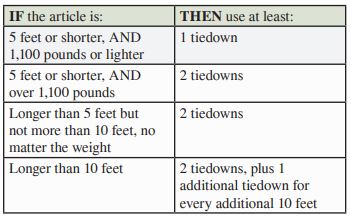Cargo Securement
Secure cargo to prevent hazards
Proper cargo securement is a make-or-break hazard situation — sometimes literally. Failing to properly secure a load can result in citations, fines, accidents, damages, and even loss of life. It’s a professional driver’s job to safely and efficiently transport cargo to the customer damage free and on time. Proper cargo securement is required by the Federal Motor Carrier Safety Regulations (FMCSRs) and addressed in the Federal Motor Carrier Safety Administration’s
(FMCSA’s) Compliance, Safety, Accountability (CSA) program.
TIP: Distribute copies of the FMCSRs to your drivers. Review and discuss the applicable sections of Part 393, Subpart I.
General cargo securement requirements
According to Sections 391.13 and 392.9 of the FMCSRs:
- A driver must know how to properly locate, distribute, and secure cargo. The regulations require drivers to be familiar with the proper cargo securement methods and procedures in or on the vehicle.
- A vehicle may not be driven unless the cargo is correctly secured with its weight appropriately distributed.
- The vehicle elements that must be secured include:
the tailgate, tailboard, doors, tarps, spare tire, and operational equipment.
Rules for cargo
The vehicle’s cargo must not:
- Block the driver’s view ahead or to the right/left sides,
- Interfere with the driver’s arm or leg movement,
- Prevent the driver from reaching emergency equipment, or
- Prevent the driver or anyone else from exiting the vehicle.
The driver must check the cargo and its securement devices at the start of the day and then again within the first 50 miles of the trip to ensure stability. Following this inspection, drivers must reexamine the load’s security after 3 hours, 150 miles, or when making a change of duty status — whichever comes first.
Exemptions
A driver may be exempt if:
- The vehicle is sealed,
- The driver has been ordered not to open or inspect the cargo, or
- The cargo has been loaded in a way that makes it impractical to inspect.
TIP: Provide drivers with a quick-reference card that they can use to determine tiedown needs on the road.
How many tiedowns do you need?
In addition to meeting the standard for the aggregate working load limit (WLL), the minimum number of tiedowns required to secure an article or group of articles in the cargo depends on:
• The length of the article(s) being secured, and
• The weight of the article(s).
Section 393.110 of the FMCSRs specifies the minimum number of tiedowns that must be used.

When an article is blocked, braced, or immobilized to prevent forward movement, it must be secured by at least one tiedown for every 10 feet of article length.
TIP: End your training with a question and answer session.
